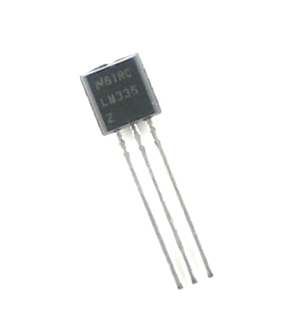This translates into the circuit schematic: This output reading of Now the computer is connected to the arduino. We will integrate this with the arduino to measure the temperature. We can then easily convert this value into fahrehnheit and celsius by plugging in the appropriate conversion equations. Pin 1 is the Adjustable Pin Adj. 
| Uploader: | Kigajind |
| Date Added: | 1 July 2010 |
| File Size: | 39.20 Mb |
| Operating Systems: | Windows NT/2000/XP/2003/2003/7/8/10 MacOS 10/X |
| Downloads: | 85604 |
| Price: | Free* [*Free Regsitration Required] |
Pin 2 gives an output of 1 millivolt per 0. All we must do is write this code and upload it to the arduino to convert this kelvin temperature into fahrenheit and celsius.
Once we have this ratio, we then multiply it dztasheet to give the millivolt value.

Pin 3 is the ground pin and connects to the ground GND terminal of the arduino. The arduino, with suitable code, can then interpret this measured analog voltage and output to us the temperature in degrees Kelvin, Celsius, and Fahrenheit. This output reading of Pin 1 is the Adjustable Pin Adj. This is so that we can hook our arduino to a computer and send it code that it can run to display to us the temperature.

The difference between an LM and LM34 and LM35 temperature sensors is datwsheet LM sensor gives out the temperature in degrees Kelvin, while the LM35 sensor gives out the temperature in degrees Celsius and the LM34 sensor gives out the temperature in degrees Fahrenheit.
So, for example, if the output pin, pin 2, datazheet out a value of mV 0. Once we obtain this Celsius value, we can convert into Fahrenheit with the following equation: The output pin provides an analog voltage output that is linearly proportional to the datashfet temperature. We will integrate this with the arduino to measure the temperature.
The type B side of the connector goes into the arduino and the type A side into the USB port of the computer.
HTTP This page has been moved
Pin 2 is the output pin. So if the LM is giving an output reading of 2.
It is divided by because a span of occupies 5V. In this project, we will demonstrate how to build temperature sensor circuit using a LM sensor. As a temperature sensor, the circuit will read the temperature of the surrounding environment and relay this temperature to us dataasheet in degrees Kelvin.
We can use any type of arduino board.
National Semiconductor
Now the computer is connected to the arduino. We can then easily convert this value into fahrehnheit and celsius by plugging in the appropriate conversion equations.
Before we can get a Kevlin reading of the temperature, the analog output voltage must first be read.
Below is the pinout of the LM IC: We get the ratio of the raw value to the full span of and then multiply it by to get the millivolt value. This is ideal because the arduino's power pin gives out 5V of power.
LM Datasheet(PDF) - STMicroelectronics
om335 The arduino will then read this measured value from the LM and translate into degrees kelvin, fahrenheit and celsius, which we will be able to read from the computer from the arduino serial monitor. This is because there is millvolts in 5 volts. So to get the degree value in fahrenheit, all that must be done is to take the voltage output and divide it by this give out the value degrees in fahrenheit.
This allows us to calibrate the temperature sensor if we want a more precise temperature readout. You can adjust this value to meet datashheet personal preference or program needs.
This is the datasheet of the LM IC: All daatsheet are calibrated different to output the millivolt voltage reading in proportional to these different units of measurement.
The raw voltage over this value therefore represents the ratio of how much power the output pin is outputting against this full range. All you have to do is take the output reading and divide it by 10 in order to get the temperature output reading. Since the output pin can give out a maximum of 5 voltsrepresents the full possible range it can give out.
We can now write code in the processing software to give instructions to the arduino.

Комментарии
Отправить комментарий